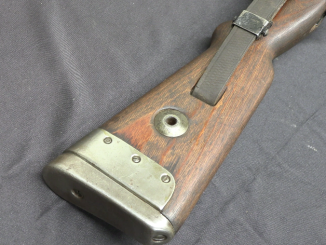Ott-Helmuth (Otto, after he emigrated to the US) von Lossnitzer was a remarkable firearms engineer. He served through World War One as a machine gunner, gaining extensive experience with a variety of different machine guns that were rebuilt in 8x57mm for German military use, and was called back into service with German ordnance during the 1920s. He became a recognized authority on small arms design and use, and in 1933 was approached by Mauser to head up their new R&D department. This job he held until 1945, when the war ended.
In 1947, von Lossnitzer emigrated to the US under Operation Paperclip, and went to work for Springfield Arsenal. In 1957 he was promoted to Supervisor Engineer of small arms R&D for Springfield, and he remained in that role until the Arsenal closed – being responsible for the 20mm Vulcan cannon among many other projects. He then spent 3 years working for Army Material Command, until the mandatory retirement age of 70. He followed this with a private job working on cartridge development, and in the 1970s dictated this memoir of his time at Mauser. The work was organized by Leslie Field, edited and fact-checked by Bas Martens, and ultimately published by Henk Visser.
Available from Mowbray, this memoir is a must-have reference for serious students of small arms development. Mauser was a hotbed of excellent engineering work during and before WW2, and Lossnitzer had an excellent memory of what the company did. From large scale projects like taped-bore antitank weapons to rotary aircraft cannon to small but essential work on spring testing machines and high speed cameras, the book is chuck full of fascinating data.
In total, its 380 pages are roughly one third memoir and two thirds supplemental documents, including a complete copy of the CIOS report on Mauser and translations of Mauser’s monthly research institute reports from October 1943 to February 1945. It is a detailed book with a pretty limited target audience, and once it is sold out I would be very surprised to see a second printing – publication was financed by Visser because of its historical importance, and not because it would be a profitable enterprise




The link to Mowbray is broken.
It appears the Mowbray website is down at the moment- maybe too many fans of Forgotten Weapons flooding it to buy the book 😉
Your reviews prompted me to buy the Firearms Developed and Manufactured in Southern Africa book and the Weapons of Choice book.
You really got me interested the von Lossnizer book – alas, as noted by someone else, the url you provided does not help in getting the book.
Please provide more info on where to buy.
Regards
“Operation Paperclip(…)Mauser was a hotbed of excellent engineering work during and before WW2”
Here you can see description (Deutsch) and drawings of Sonderwaffe HF 15:
http://www.germanluftwaffe.com/archiv/Dokumente/ABC/s/SG%20Sondergeraete/Sonderwaffe%20HF%2015/Sonderwaffe%20HF%2015.html
as you can see at 2nd photo from top, one cartridge for this weapon contained several bullets (15 mm diameter in final version) arranged in spiral manner which were fired subsequently, with Rate-of-Fire equal to 30000…40000 rpm (though this is only “internal” or “short-term” Rate-of-Fire, that is counted “inside” one cartridge) with velocity 1000 m/s to 800 m/s.
Did you know any further (post WWII) development of this weapon?
Most unusual… mind boggling weapon concept. This is, as I understand from Fall of 1944, while pressure on Luftwaffe was unsurmountable. It is understandable they tried everything in physical world. I have had great respect for Mauser’s aerial armaments for long time.
“I have had great respect for Mauser’s aerial armaments for long time.”
Not aerial, but also Mauser developed was EW141 – armament for Panzerkampfwagen I Ausf. C
This weapon belong to rarely encountered class of weapon: tank[-mounted] anti-tank self-loading belt-fed rifle. It uses Patrone 318.
–
Data for HF-15 cartridge from Альбом конструкций патронов стрелкового оружия:
One cartridge contain 9 bullets, cartridge overall length is 161 mm, maximal diameter 75,8 mm, bullet maximal diameter is 15,57 mm, length 57 mm.
“Most unusual… mind boggling weapon concept.”
In link there are drawings there are drawings for two concept: single (containing only one cartridge and thus having capacity 9) and Trommelprojekt mit 5 Hülsen (cylinder with 5 cases).
First one was used to create 5-cluster, which mass was equal 100 kg, which was supposed to be installed in each wing, giving overall capacity of 90.
–
It also says idea of such weapon comes from Hungarian Leutnant Zettl – which was inspired by how shotgun works – initially it was 7 x 15 mm in 7,5 cm case. Accuracy was as follow: all 7 projectiles were inside 10 x 10 cm square at distance 100 m. Muzzle velocity was 1000 m/s for first and 800 m/s for last projectile.
Now I see linked site in Technische Daten HF 15 give different data for cartridge than Альбом конструкций патронов стрелкового оружия, but this can be easily explained, as multiple various version might be created and tested during development.
Can you provide link(s)? Thank you.
All data for HF 15 (excluding that from Альбом конструкций патронов стрелкового оружия), are from already linked site:
http://www.germanluftwaffe.com/archiv/Dokumente/ABC/s/SG%20Sondergeraete/Sonderwaffe%20HF%2015/Sonderwaffe%20HF%2015.html
I (living in Germany) got my copy from the Netherlands several years ago. Will try to find the address.
It appears that Forgotten Weapons fans have completely bought up all the copies of the book from Mowbray- hopefully they decide to print more! 🙂
Sorry for getting to the party after it’s over.
Just on operation paperclip and the economic background to the war in Europe, and the united state’s economic aims and motives in the war to make all wars…
The deep background includes the funding of the war to make a world safe for Lenin, Trotsky, Mussolini aaand Hitler… By inflation of paper money and the British attempt to go back onto a gold standard after the war at the old par of $4.86 to the pound sterling, but without deflating the supply of paper money, and instead continuing to inflate it. And getting everyone else in the world to inflate paper money too.
Long story short, the result was 20 years of hideous economic recession in Britain, and inflationary bubbles every where else, followed by the european hyper inflations and the collapse of the interwar “gold exchange standard” into dirty floating, competing paper currencies.
Within that post crash chaos, The German state was very effective at setting up bi lateral barter arrangements with other countries; German machine tools and manufactured goods in exchange for food and raw materials.
German municipalities were also in debt to united state lenders, they’d taken advantage of the earlier cheap credit to “invest” in new town halls.
The municipalities were unable to repay, as united state tarriffs excluded German exports, so dollars could not be earned.
The German bilateral trade deals were seen by the united state, as “Threatening world peace” – as no one in those countries could sell into the united state to earn dollars to buy American exports, because of the tarriff.
United state tarriffs were seen as “non discriminatory” because they shut every one out
But German bi lateral export agreements, that competed with American exports (that no one could get the dollars to pay for), “threatened world peace”
Post war,
Not only was American paper money inflation exported under the Bretton woods agreement
And yet more dollars sent out so that the rest of the world could buy American, under the Marshall Plan…
But plants were variously blown up, or moved to the Soviet union and the united state, along with technical libraries, archives and technical people
The 2/3 reduction of the German population and the backfilling of mines to reduce Germans to a wholly agricultural future, foreseen by the morganthau plan, never went to full fruition
But Von Lossnitzer’s Babylonian exile can be seen in a far wider context of the economic aims of the united state.
Time and again, Hamiltonian tarriffs and the interests of bankers and industrialists are a far more likely and convincing explanation for wars, than the reasons given by the court historians.
Von Lossnitzer alert ! Mobray has restocked.
Just got my copy today.
Thanks for this book review. I like reading books of such genres because it’s the most interesting ones for me. And I’m never bored reading them, because, for example, when I read something from classical literature, I can get pretty bored and just stop. For me, history has always been interesting, and two weeks ago, our professor told us about one method called historical criticism. It’s about examining the text’s historical origins, such as the time and place in which the text was written, its sources, events, dates, places and so on. Also, I found some examoles on this page https://graduateway.com/essay-examples/historical-criticism/ which helped me to understand everything better. And now, I’m curious whether such a method can be used in any book, for example, this one. I’ll try to do it because it’s my task, so of course, I’d start with the genre I like, and I hope I’ll succeed.